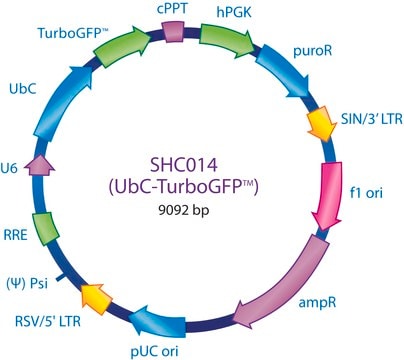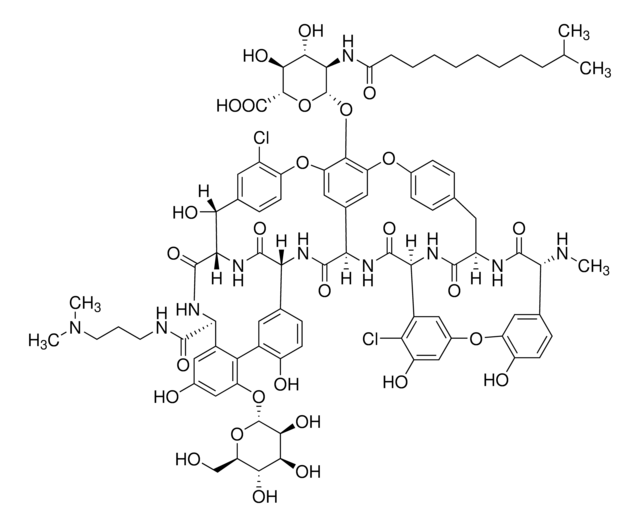SHC012V
MISSION® pLKO.1-puro-CMV-TagRFP™ Positive Control Transduction Particles
Contains a gene encoding TagRFP
Synonym(s):
MISSION®, MISSION® Control Transduction Particles
Sign Into View Organizational & Contract Pricing
All Photos(1)
About This Item
UNSPSC Code:
41106609
NACRES:
NA.51
Recommended Products
product line
MISSION®
concentration
≥1x106 VP/ml (via p24 assay)
technique(s)
capture ELISA: 106 TU/mL using p24
shipped in
dry ice
storage temp.
−70°C
Looking for similar products? Visit Product Comparison Guide
Related Categories
General description
Self-inactivating replication incompetent viral particles are produced in packaging cells (HEK293T) by co-transfection with compatible packaging plasmids. In addition, the Control Transduction Particles are pseudotyped with an envelope G glycoprotein from Vesicular Stomatitis Virus (VSV-G), allowing transduction of a wide variety of mammalian cells. 200 μl of 106 TU/ml (via p24 titering assay) lentiviral particles are provided as frozen stock.
When conducting experiments using MISSION® shRNA clones, the proper controls should be a key element of your experimental design to allow for accurate interpretation of knockdown results. The MISSION Control Transduction Particles are a critical positive control to monitor transduction efficiency.
To see more application data, protocols, vector maps visit sigma.com/shrna.
To see more application data, protocols, vector maps visit sigma.com/shrna.
Application
MISSION® pLKO.1-puro-CMV-TagRFP™ Positive Control Transduction Particles has been used to knockdown transient receptor potential vanilloid 1 receptor (TRPV1)-like receptors. It has also been used to generate fluorescent cell lines.
MISSION®pLKO.1-puro-CMV-TagRFP™ Positive Control Transduction Particles has been used in generating fluorescent cell lines by transduction. It has also been used in transfection of human dermal fibroblast (HDF), WI-38 and IMR-90 FBs to express tagRFP.
To see more application data, protocols, vector maps visit sigma.com/shrna.
When conducting experiments using MISSION shRNA clones, the proper controls should be a key element of your experimental design to allow for accurate interpretation of knockdown results. The MISSION TagRFP Control Transduction Particles are a positive control to monitor transduction efficiency. The MISSION TagRFP Control Transduction Particles are produced from the sequence-verified 8594 base pair lentivirus plasmid, pLKO.1-puro-CMV-TagRFP (SHC012).
This construct aids in interpretation of experimental design and results by providing a red fluorescent protein marker for monitoring success in transduction of your cells of interest.
This construct aids in interpretation of experimental design and results by providing a red fluorescent protein marker for monitoring success in transduction of your cells of interest.
Legal Information
MISSION is a registered trademark of Merck KGaA, Darmstadt, Germany
TagRFP is a trademark of Evrogen Co.
recommended
Product No.
Description
Pricing
Storage Class Code
12 - Non Combustible Liquids
WGK
WGK 3
Flash Point(F)
Not applicable
Flash Point(C)
Not applicable
Certificates of Analysis (COA)
Search for Certificates of Analysis (COA) by entering the products Lot/Batch Number. Lot and Batch Numbers can be found on a product’s label following the words ‘Lot’ or ‘Batch’.
Already Own This Product?
Find documentation for the products that you have recently purchased in the Document Library.
Activation of temperature-sensitive TRPV1-like receptors in ARC POMC neurons reduces food intake
Jeong JH, et al.
PLoS Biology, 16(4), e2004399-e2004399 (2018)
High EMT signature score of invasive non-small cell lung cancer (NSCLC) cells correlates with NF kappa B driven colony-stimulating factor 2 (CSF2/GM-CSF) secretion by neighboring stromal fibroblasts
Rudisch A, et al.
PLoS ONE, 10(4), e0124283-e0124283 (2015)
A high-content image-based method for quantitatively studying context-dependent cell population dynamics.
Garvey CM
Scientific Reports, 6, 29752-29752 (2016)
Albin Rudisch et al.
PloS one, 10(4), e0124283-e0124283 (2015-04-29)
We established co-cultures of invasive or non-invasive NSCLC cell lines and various types of fibroblasts (FBs) to more precisely characterize the molecular mechanism of tumor-stroma crosstalk in lung cancer. The HGF-MET-ERK1/2-CREB-axis was shown to contribute to the onset of the
Jae Hoon Jeong et al.
PLoS biology, 16(4), e2004399-e2004399 (2018-04-25)
Proopiomelanocortin (POMC) neurons in the arcuate nucleus of the hypothalamus (ARC) respond to numerous hormonal and neural signals, resulting in changes in food intake. Here, we demonstrate that ARC POMC neurons express capsaicin-sensitive transient receptor potential vanilloid 1 receptor (TRPV1)-like
Our team of scientists has experience in all areas of research including Life Science, Material Science, Chemical Synthesis, Chromatography, Analytical and many others.
Contact Technical Service






